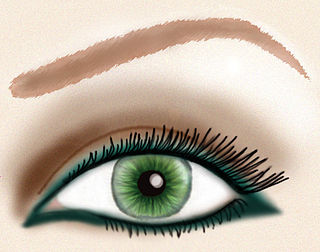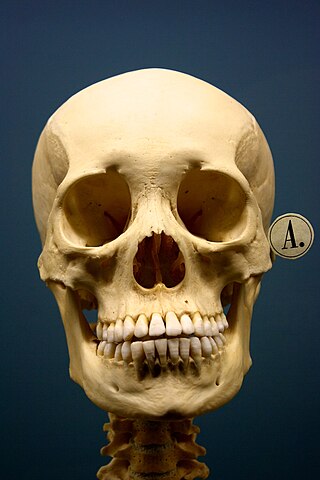
Hair gel is a hairstyling product that is used to harden hair into a particular hairstyle.

Hair gel is a hairstyling product that is used to harden hair into a particular hairstyle.
Analysis of ancient Egyptian mummies has shown that they styled their hair using a fat-based gel. The researchers behind the analysis say that the Egyptians used the product to ensure that their style stayed in place in both life and death. Natalie McCreesh, an archaeological scientist from the KNH Centre for Biomedical Egyptology at the University of Manchester, England, and her colleagues studied hair samples taken from 18 mummies. The oldest is approximately 3,500 years old, but most were excavated from a cemetery in the Dakhleh Oasis in the Western Desert and date from Greco-Roman times, around 2,300 years ago. [1]
The Irish bog body Clonycavan Man, which has been radiocarbon dated to between 392 BC and 201 BC, was found to have been using a hair gel made from pine tree resin imported from Spain or South-west France. [2]
In 1914, in a small pharmacy located in the heart of Buenos Aires, Argentina (Florida at 600), veterinary student José Antonio Brancato mixed a fixative for hair which would carry the name "gomina" as a registered trademark. For this, he mixed gum Arabic, Persian tragacanth and different essences. Soon the word "gomina" became synonymous with fixative. A fixative that displaced the soaps and oils used for this purpose.
In 1929, the British company Chemico Works invented Brylcreem, which became the market leader among hair styling products in both the U.K. and the U.S. during the following decades.
In the 1960s, modern hair gel was invented in the United States, by what would later be renamed the Dep Corporation. Marketed under the brand name Dep, modern hair gel was given this name by its inventor, Luis Montoya, in recognition of the substance that gave it its unique, non-greasy consistency: diethyl phthalate, commonly abbreviated as DEP.[ citation needed ]

Many brands of hair gel in North America and the UK come in numbered variants. Higher numbered gels maintain a greater "hold" on hair, while lower numbers do not make the hair as stiff and in some products give the hair a wet look. One category of hair gels is designed and manufactured specifically for sculpting the hair texture common to people of African descent. Other ethnic groups who are known for using hair gel include Mediterraneans, Eastern Europeans, and Latin Americans.
Some forms of hair gel are marketed to consumers who want to "spike" their hair in the style that emerged from the hardcore punk subculture in the 1980s. Some hair gels include temporary hair coloring, which includes variants in unnatural colors associated with various subcultures, such as the goths, ravers, mobsters, and greasers.
Cationic polymers are among the main functional components of hair gel. The positive charges in the polymers causes them to stretch, making the gel more viscous. Hair gels resist natural protein conformations and allow hair to be styled and textured, because the stretched-out polymer takes up more space than a coiled polymer and thus resists the flow of solvent molecules around it. The positive charges also bind the gel to the negatively charged amino acids on the surface of the keratin molecules in the hair.[ citation needed ]
More complicated polymer formulas exist; i.e., a copolymer of vinylpyrrolidone, methacrylamide, and N-vinylimidazole.[ citation needed ]

A mummy is a dead human or an animal whose soft tissues and organs have been preserved by either intentional or accidental exposure to chemicals, extreme cold, very low humidity, or lack of air, so that the recovered body does not decay further if kept in cool and dry conditions. Some authorities restrict the use of the term to bodies deliberately embalmed with chemicals, but the use of the word to cover accidentally desiccated bodies goes back to at least the early 17th century.

Mummy portraits or Fayum mummy portraits are a type of naturalistic painted portrait on wooden boards attached to upper class mummies from Roman Egypt. They belong to the tradition of panel painting, one of the most highly regarded forms of art in the Classical world. The Fayum portraits are the only large body of art from that tradition to have survived. They were formerly, and incorrectly, called Coptic portraits.

Dreadlocks, also known as dreads or locs, are rope-like strands of hair formed by matting which is done by not combing the hair and allowing the hair to mat naturally or by twisting hair and over time the twisted hair will form into matted locs.

In English slang, a Croydon facelift is a particular hairstyle worn by some women. The hair is pulled back tightly and tied in a bun or ponytail at the back. The supposed result is that the skin of the forehead and face are pulled up and back, producing the effects of a facelift.

Hair wax is a thick hairstyling product containing wax, used to assist with holding the hair. In contrast with hair gel, most of which contain alcohol, hair wax remains pliable and has less chance of drying out. It is often sold under names such as pomade, putty, glue, whip, molding gum, or styling paste. The texture, consistency, and purpose of these products varies widely and each has a different purported purpose depending on the manufacturer. Traditionally, pomade is a type of hair wax that also adds shine to one's hair.

Hair conditioner is a hair care cosmetic product used to improve the feel, texture, appearance and manageability of hair. Its main purpose is to reduce friction between strands of hair to allow smoother brushing or combing, which might otherwise cause damage to the scalp. Various other benefits are often advertised, such as hair repair, strengthening, or a reduction in split ends.

Hair mousse, also referred to as styling foam, is a hairstyling product to protect, control, and style hair. "Mousse" originates from a French term meaning foam. Hair mousse originated in France and was brought to the North American retail market by L'Oreal in the 1980s.

Cornrows are a style of braids in which the hair is braided very close to the scalp, using an underhand, upward motion to make a continuous, raised row. Cornrows are often done in simple, straight lines, as the term implies, but they can also be styled in elaborate geometric or curvilinear designs.

Pomade is a greasy, waxy, or water-based substance that is used to style hair. It generally gives the user's hair a shiny, slick appearance. It lasts longer than most hair-care products, and often requires multiple washes for complete removal. The pomades of the 18th and 19th centuries consisted mainly of bear fat or lard. Lanolin, beeswax and petroleum jelly have been used extensively in modern pomades. The hold of pomades makes sculptured hairstyles such as the pompadour waves (hairstyle) possible.

Liberty spikes is hair styled into long, thick, upright spikes. The style, now associated with the punk subculture, is so named because of the resemblance to the diadem crown worn by the Statue of Liberty, itself inspired by the Roman goddess Libertas and god Sol Invictus.

Carboxymethyl cellulose (CMC) or cellulose gum is a cellulose derivative with carboxymethyl groups (-CH2-COOH) bound to some of the hydroxyl groups of the glucopyranose monomers that make up the cellulose backbone. It is often used as its sodium salt, sodium carboxymethyl cellulose. It used to be marketed under the name Tylose, a registered trademark of SE Tylose.

A bouffant is a type of puffy, rounded hairstyle characterized by hair raised high on the head and usually covering the ears or hanging down on the sides.
Joann Fletcher is an Egyptologist and an honorary visiting professor in the department of archaeology at the University of York. She has published a number of books and academic articles, including several on Cleopatra, and made numerous television and radio appearances. In 2003, she controversially claimed to have identified the mummy of Queen Nefertiti.

Big hair is a hairstyle that emphasizes large volume or largely styled hair, especially when those styles make the hair occupy a large amount of space above and around the head. The label "big hair" for such styles originated in the late 1970s, when these styles were beginning a period of popularity. Similar styles have become fashionable at various periods in history.

Eye liner or eyeliner is a cosmetic used to define the eyes. It is applied around the contours of the eye(s). It is often used to create various aesthetic effects.
Hairstyle products are used to change the texture and/or shape of hair.

Surfer hair is a tousled type of hairstyle, popularized by surfers from the 1950s onwards, traditionally long, thick and naturally bleached from high exposure to the sun and salt water of the sea. In the late 1960s and 1970s, the long hair and general lack of personal grooming was closely associated with hippie culture. Today, hairstyling companies brand their own hair gels, shampoos and hair wax to achieve the "surfer look" with hairstyles that are often shorter than traditionally, which often require more grooming to achieve the permanent hair lift or intentional windswept look. Amongst women, fashion magazines have referred to "sun streaked surfer hair" as a desirable look for women, although genuine surfer hair is often heavily damaged by the elements.

Nail art is a creative way to paint, decorate, enhance, and embellish nails. It is a type of artwork that can be done on fingernails and toenails, usually after manicures or pedicures.

The conservation and restoration of human remains involves the long-term preservation and care of human remains in various forms which exist within museum collections. This category can include bones and soft tissues as well as ashes, hair, and teeth. Given the organic nature of the human body, special steps must be taken to halt the deterioration process and maintain the integrity of the remains in their current state. These types of museum artifacts have great merit as tools for education and scientific research, yet also have unique challenges from a cultural and ethical standpoint. Conservation of human remains within museum collections is most often undertaken by a conservator-restorer or archaeologist. Other specialists related to this area of conservation include osteologists and taxidermists.